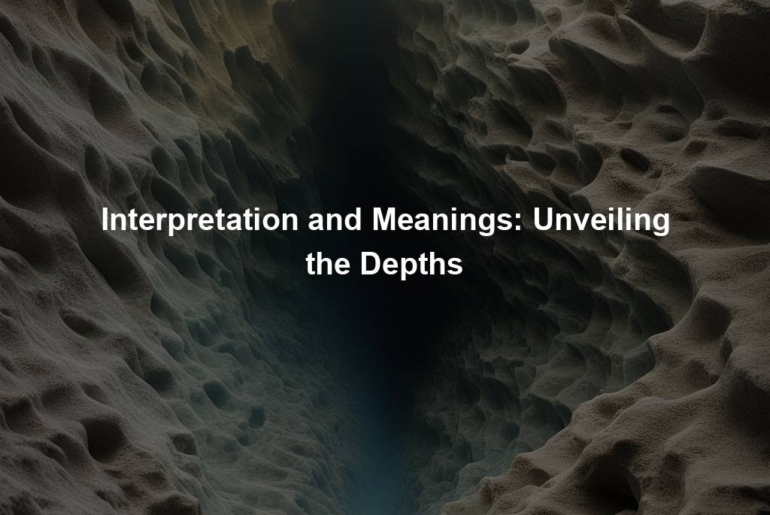Interpretation and meanings are essential components of human communication and understanding. They allow us to delve into the rich depths of various forms of expression, such as art, literature, language, and even daily interactions. Unveiling these depths requires a thoughtful and nuanced approach, as the true essence and intended message may not always be apparent on the surface. By exploring different layers and perspectives, we can unlock new dimensions of meaning that enhance our comprehension and appreciation of the world around us.
The Multifaceted Nature of Interpretation
Interpretation is a multifaceted process, influenced by various factors such as cultural context, personal experiences, and individual beliefs. It involves extracting meanings from symbols, signs, words, and actions, which can often be subject to diverse and even contradictory interpretations. These different viewpoints contribute to the richness and complexity of our understanding, demonstrating the dynamic nature of interpretation.
Cultural Interpretation
Cultural interpretation plays a significant role in our understanding of various artistic and literary forms. The meanings embedded in a piece of art or a literary work are not solely determined by the artist or the author. Instead, they are shaped and interpreted through the cultural lens of the observer. Different cultures may attribute different connotations and symbolisms to the same object or text, leading to an array of diverse interpretations.
Subjective Interpretation
Subjectivity also plays a crucial role in interpretation. Each individual brings their unique set of experiences, emotions, and beliefs, which color their understanding of a particular message. A simple phrase or image can evoke different emotions or ideas in different people, highlighting the subjective nature of interpretation. Subtleties and nuances gain significance as individuals relate them to their own personal narratives, giving rise to a multitude of meanings.
Expanding Perspectives: Going Beyond the Obvious
Unveiling the depths of any form of expression necessitates a willingness to dig deeper and explore beyond the obvious. It means looking beyond the surface-level interpretation and attempting to uncover hidden layers of meaning. This requires critical thinking, empathy, and an open mind, as well as a consideration of different cultural, historical, and social contexts that may influence the message.
Symbolism and Metaphor
Symbolism and metaphor are powerful tools that add depth and complexity to communication. They allow for a more nuanced understanding by using one object or concept to represent another. Unlocking the meanings behind symbols and metaphors can offer profound insights into both the message being conveyed and the intentions of the communicator. Engaging with symbolism and metaphor invites us to embrace abstract thinking and explore various interpretations.
Intertextuality and Allusion
Interpretation is not confined solely to the immediate text or artwork but can expand across different works or mediums. Intertextuality and allusion refer to the practice of referencing or borrowing ideas, themes, or symbols from other works. Delving into intertextuality allows for a deeper appreciation of the connections between different texts or artworks, shedding light on hidden meanings and creating intricate webs of interpretation.
The Journey of Interpretation
Interpretation is a journey, rather than a destination. Each exploration of meaning offers fresh insights and challenges preconceived notions. It is an ongoing process that evolves with the accumulation of knowledge and experiences, allowing for personal growth and a deeper understanding of the world.
The Role of Context
Context is an integral part of interpretation. Understanding the historical, social, and cultural context within which a message was produced provides valuable clues for unraveling its intended meaning. By considering the context, we gain a more comprehensive understanding of the message and the motivations behind it.
The Importance of Dialogue
Interpretation is enhanced through dialogue and the exchange of ideas. Engaging in discussions with others who have different perspectives and interpretations can challenge our own ideas and expand our understanding. By embracing diversity and actively seeking alternative viewpoints, we are better equipped to unveil the depths and uncover new meanings.
Conclusion
Interpretation and meanings are the key to understanding the complexities and intricacies of our world. Unveiling the depths requires not only a willingness to explore different layers of interpretation but also an acknowledgement of the subjective nature of meaning. By engaging in a continuous process of interpretation, considering cultural and individual perspectives, and embracing dialogue, we can unlock new dimensions of understanding and appreciation for the richness that lies beneath the surface.

